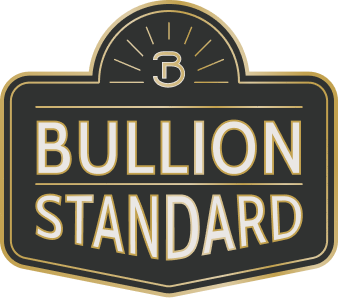The Beginner's Guide to Investing in Precious Metals
By Bullion Standard ·
6 min read
For centuries, investing in precious metals has stood the test of time as a trusted method to preserve and grow wealth – and for good reason. Gold, silver, and platinum are tangible assets that traditionally offer a safe haven in times of market turbulence.
Unlike paper assets, these metals are not susceptible to the same risks of inflation or economic downturns. Their stability and resilience make them a valuable addition to a diversified investment portfolio.
In this blog, the experts at Bullion Standard will educate you on the historical significance, economic impact, and practical benefits of investing in precious metals. Additionally, we'll provide practical advice on incorporating these metals into your investment strategy.
Let’s get into it!

What Are Precious Metals?
Precious metals were valuable thousands of years ago. Ancient civilizations used gold and silver as currency and symbols of wealth. These metals have maintained their worth and are still incredibly valuable today.
Generally, precious metals investors are most interested in these four types:
- Gold is the most popular precious metal for investment. It’s known for its stability and value retention.
- Silver prices are lower than gold, making it is a more affordable option. It also has industrial uses that drive its demand.
- Platinum is rarer than the other precious metals. It has significant industrial applications, especially in the automotive industry.
- Palladium a scarcer than platinum. It is a silvery-white precious metal used primarily in catalytic converters, electronics, and jewelry due to its excellent catalytic properties and resistance to corrosion.
Precious metals are valued by their rarity, industrial applications, and role against economic uncertainty.
The Top 3 Reasons to Invest in Precious Metals
1. They Hedge Against Inflation
Precious metals tend to retain their value, even when the value of currency drops. This makes them an excellent hedge against inflation. When inflation rises, precious metals prices often increase, protecting your purchasing power.
2. Stable in Times of Economic Uncertainty
During times of economic instability, precious metals are considered a safe haven for your finances. When stock markets are volatile, the value of precious metals typically remains stable or increases.
3. Portfolio Diversification
Adding precious metals to your investment portfolio helps diversify your assets. Diversification reduces risk by spreading investments across different asset types. This way, if one investment performs poorly, others may perform well, balancing your overall returns.
Two Ways to Invest: Physical vs Paper Investing
A common way to invest in physical precious metals is by purchasing coins and bars. This method is straightforward: you buy the metal and store it securely.
Another form of investing in physical metals is through jewelry. Jewelry’s value depends not only on the metal content but also on the craftsmanship and design. As a result, it is a less predictable investment compared to coins and bars. When considering jewelry, it’s essential to evaluate the quality and uniqueness of the pieces to ensure a worthwhile investment.
Owning physical precious metals gives you direct ownership, providing a tangible asset that you can hold onto. It’s important to keep in mind that investing in physical metals requires safe storage solutions to protect your assets from theft or damage.
Paper investments offer a convenient alternative for those that don’t want to own the physical metal.
One popular option is Exchange-Traded Funds (ETFs) which allow you to invest in precious metals. Digital gold is another alternative, allowing you to buy and sell gold online. Just make sure to use a reputable platform to avoid scams.
Another paper investment option is mining stocks. By investing in mining companies, you can gain exposure to precious metals indirectly. However, keep in mind that mining stocks come with higher risk due to the volatility of mining operations.
5 Practical Tips for Investing in Precious Metals
Investing in precious metals can be rewarding, but it's essential to approach it with a well-thought-out strategy. Here are some practical tips to help you navigate your investment journey effectively.
1. Set Clear Goals
Before you start investing, it's crucial to define your financial goals. Are you looking to hedge against inflation, diversify your portfolio, or achieve long-term growth? Your goals will significantly influence your investment strategy.
For instance, if your primary aim is to protect against inflation, you might focus more on gold. If you're seeking diversification, you might invest in a mix of metals. Clear goals will guide your decisions and help you stay focused on your investment objectives.
2. Research and Educate Yourself
Understanding the market dynamics and factors that influence precious metal prices is vital in smart investing. Stay updated on economic trends and geopolitical events that can impact these markets. Read articles, follow industry news, and consider consulting with financial experts.
The more knowledgeable you are, the better prepared you'll be to make informed decisions. Regularly educating yourself will also help you anticipate market movements and adjust your strategy accordingly.
3. Start Small
If you're new to investing in precious metals, it's wise to start with a smaller investment. This approach allows you to learn the ropes without taking on too much risk.
As you gain confidence and experience, you can gradually increase your investment. Starting small also gives you the flexibility to experiment with different types of investments, such as coins, bars, or ETFs, and find what works best for you.
4. Store Your Metals Safely
If you choose to invest in physical metals, secure storage is crucial to protect your investment. Consider using a safe deposit box at a bank or a professional storage service that specializes in precious metals.
These options provide security and peace of mind. Additionally, it's important that your storage method is insured against theft or damage for an added layer of protection.
5. Monitor Your Investments
Regularly reviewing your portfolio and staying informed about market changes is essential for successful investing. This will help you make timely decisions and adjust your strategy as needed.
Set aside time each month to check on your investments, track performance, and read up on any relevant news or developments. Being proactive in monitoring your investments ensures that you remain aligned with your financial goals and can respond quickly to market shifts.

Over to You
Investing in precious metals is a smart way to secure your financial future. These metals offer stability, act as a hedge against inflation, and provide a safe haven during economic uncertainty.
Whether you choose physical metals, paper investments, or digital gold, the key is to stay informed and be proactive. With the right approach, investing in precious metals can help you achieve your financial goals and provide peace of mind in an unpredictable world.
With a commitment to integrity and excellence, Bullion Standard offers a range of options for investors seeking to diversify their portfolios with precious metals. Explore our website to learn more.






















